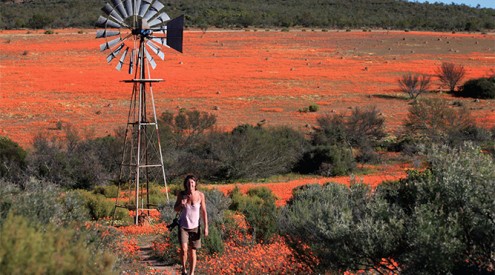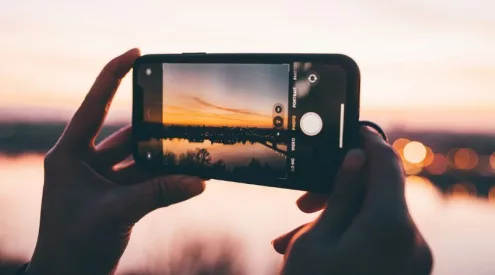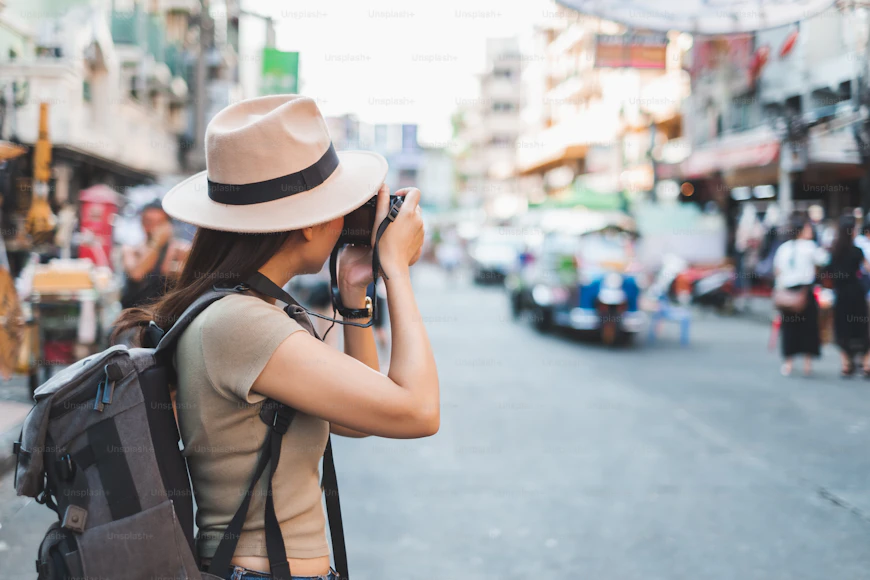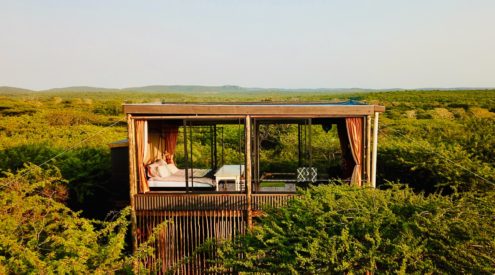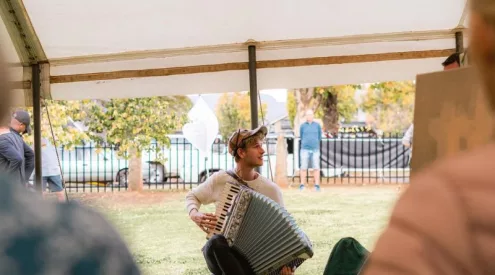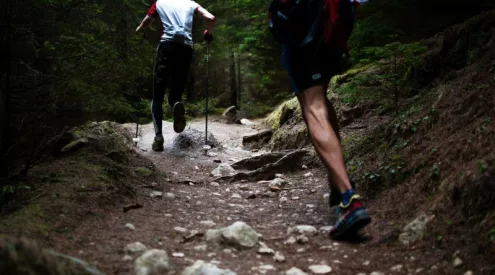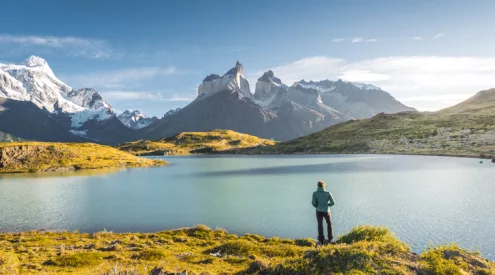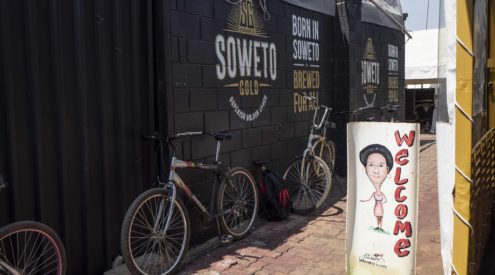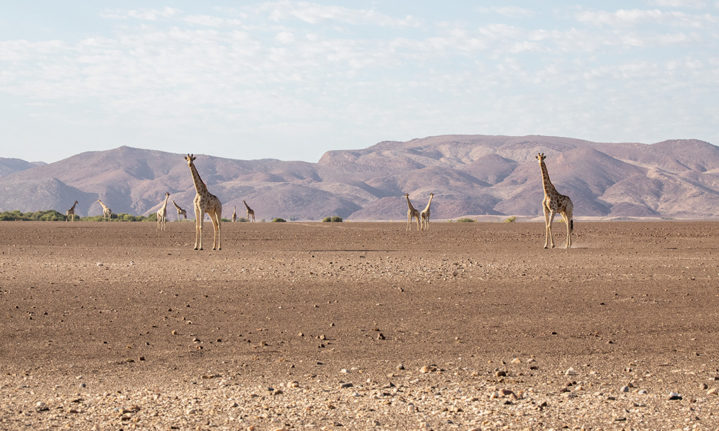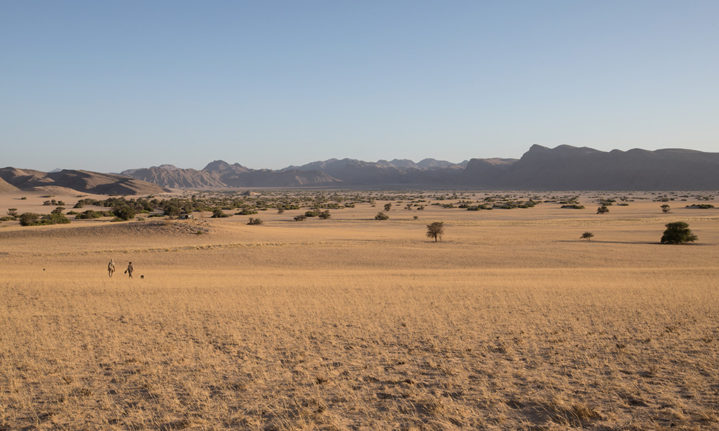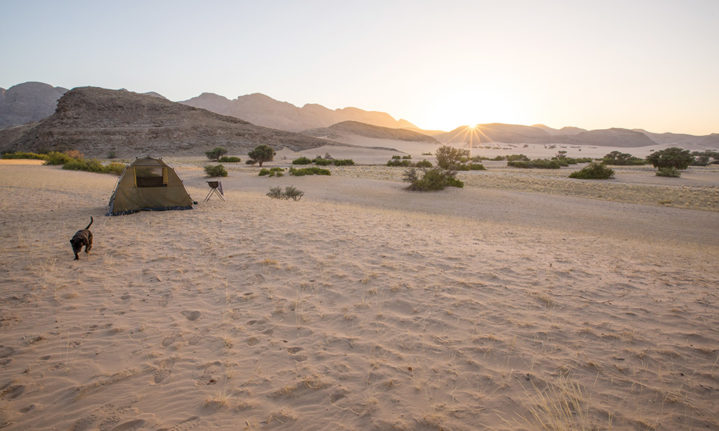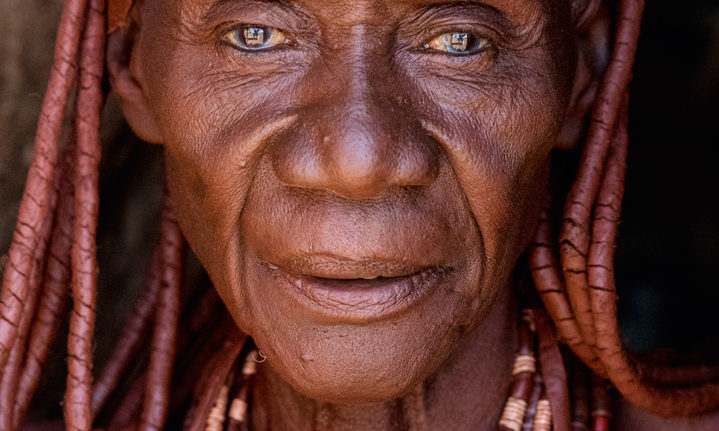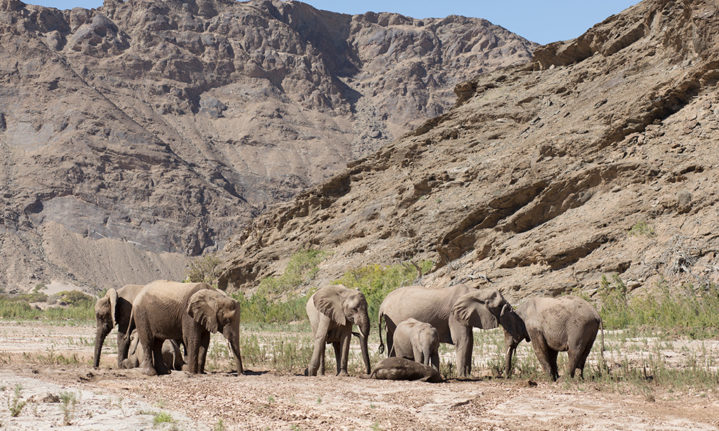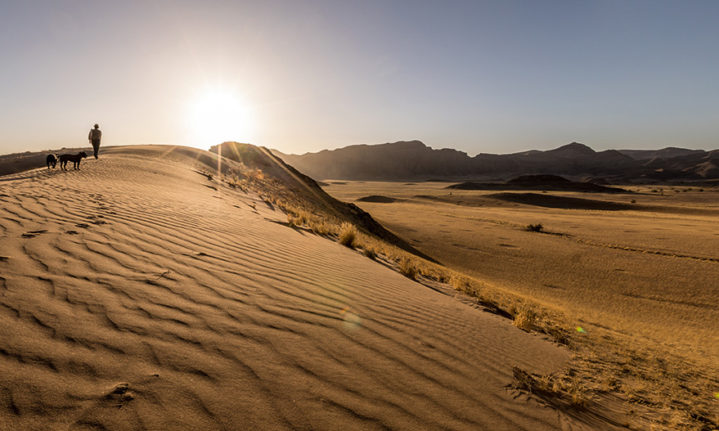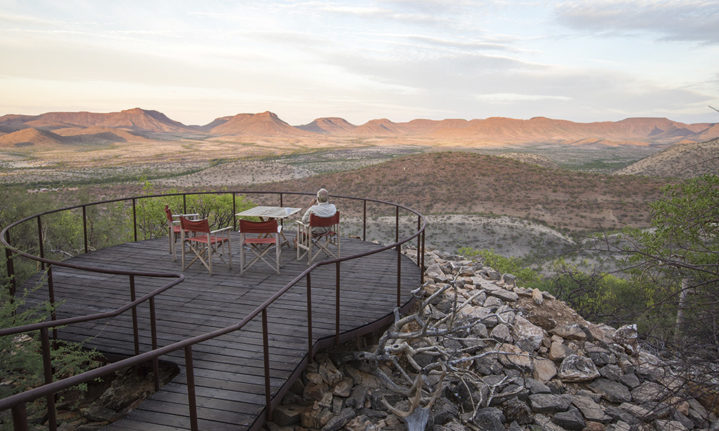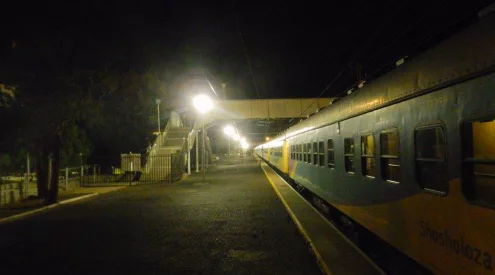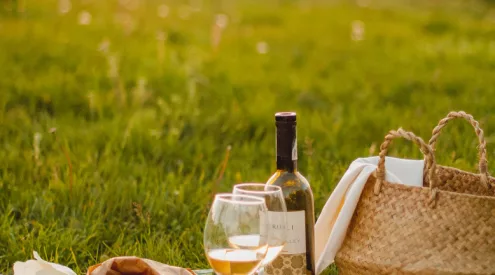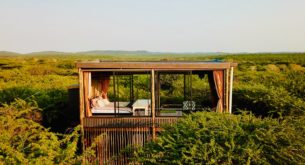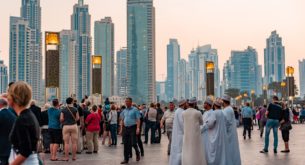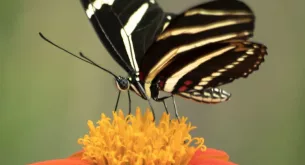A journey through Kaokoland, the most remote and wildest region of Namibia – with the people who helped preserve it.
Words & Photos Anton Crone
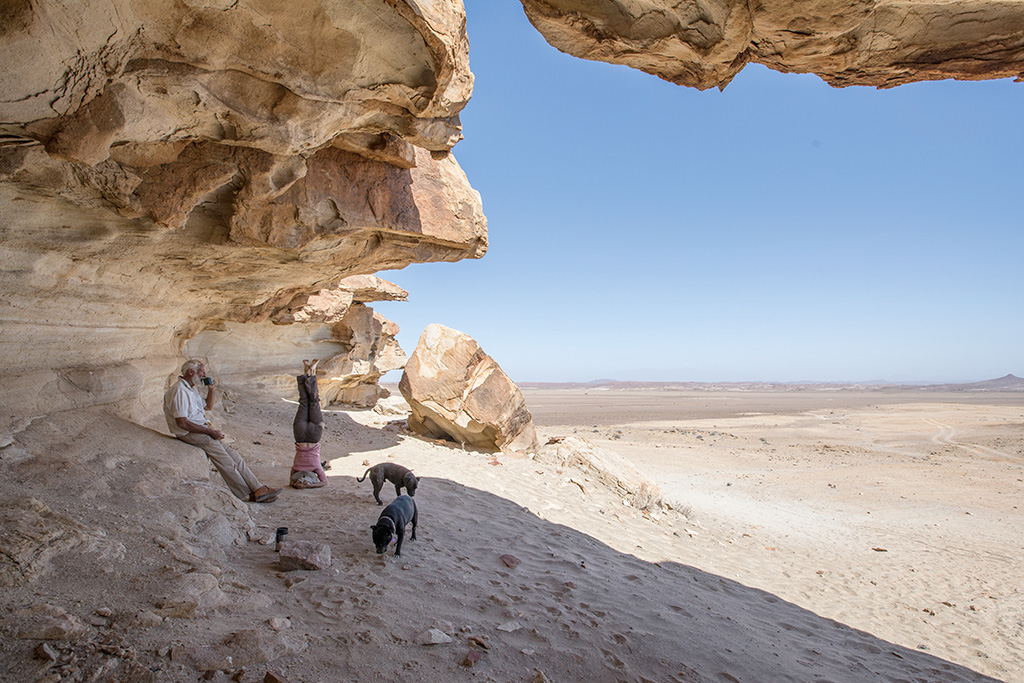
During breaks, Margie Jacobsohn would efforlessly perform one of her signature headstands to get the blood flowing after a long drive over rugged terrain.
November 2017 in the drought-ravaged north of Namibia, the hides of dead animals were draped over bones like macabre tents. Sharp rocks crackled as we rolled, driving between the remains of two giraffe and about a dozen mountain zebra. It became clear, once we got out of the vehicle to investigate, that thirst had drawn the animals to what was once a stream. Desperation had coaxed them there; a genetic signal sending them on a misguided bearing, and on finding no water, without an ounce of strength left, they had succumbed here in this rocky gully, enveloped in a suffocating shroud of heat.
The Land Rover we were travelling in was by contrast a kinetic island of shade and sustenance. We drove with the windows open, air-con being a luxury that Garth Owen-Smith and Margaret Jacobsohn seemed to abhor. Garth was at the wheel beside me and Margie was in the back, one of their Staffordshire terriers asleep on her lap, the other alongside, belly up, tongue lolling. The dog let off a deadly fart and we drove with our heads out the windows for a while, laughing and grimacing at the same time. This became a ritual, repeated for days.
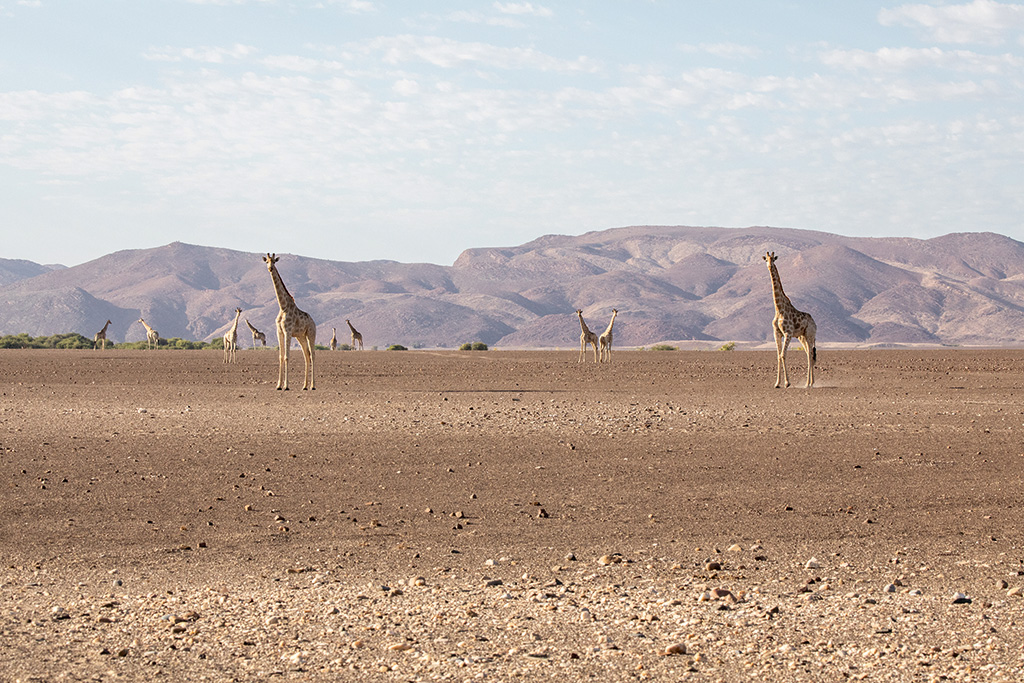
Giraffes cross the rocky plain south of Puros to browse on trees lining the Hoarsub River.
Renowned journalist Tony Weaver had introduced me to Garth and Margie after which they’d invited me on a trip through this arid Netherland in the northwest of Namibia and some of the conservancies they had been instrumental in creating. I was there to poke a stick under the curtain of human/wildlife conflict which had escalated during the drought as desperate predators took to preying on livestock. It was humbling for a journalist and amateur conservationist like me. The pair had been jointly awarded multiple times for their pioneering community-based work in conservation, the most significant being the Goldman Environmental Prize and the Prince William Lifetime Award for Conservation in Africa. Before that, Margie was a highly respected South African journalist and remains an incredible writer today. Sadly, Garth is now gone, having succumbed to cancer in April 2020, but my memory of him from that trip is as distinct as the lines on his face, chiselled by the Namibian sun. So this is not a travelogue or a guide to exploring Kaokoland, it’s really a tribute to a remarkable couple.
The toll of the drought on wildlife and livestock meant there was real horror as we drove through the desert, yet between sights like the one at the dry gully, there was also astounding beauty. Due to Garth’s extensive knowledge of the area, we often travelled ‘off-piste’ through incredible landscapes not many people had seen. Leaving rocky hills behind, we crossed a dry savannah and dropped into the dry Khowarib riverbed a few hours after leaving the gully. Tall trees soon lined the banks of our sandy highway and ostriches raced alongside. These riverbeds were Garth and Margie’s back roads, a complex network inherent to them after decades of exploration. Before long, the riverbanks grew into red cliffs and as the river wound between them, every corner revealed a vista more magnificent than the last. Bee-eaters shot out of nesting tunnels in the sand banks, raptors rode the thermals rising up cliff walls, a large herd of goats and the first humans we had seen in two days rested in the shade beneath a large tree. And then water, lovely water, tricking between the rocks then down into a pool rimmed with tall reeds where Garth and I stripped down while Margie bathed modestly a little further downstream.
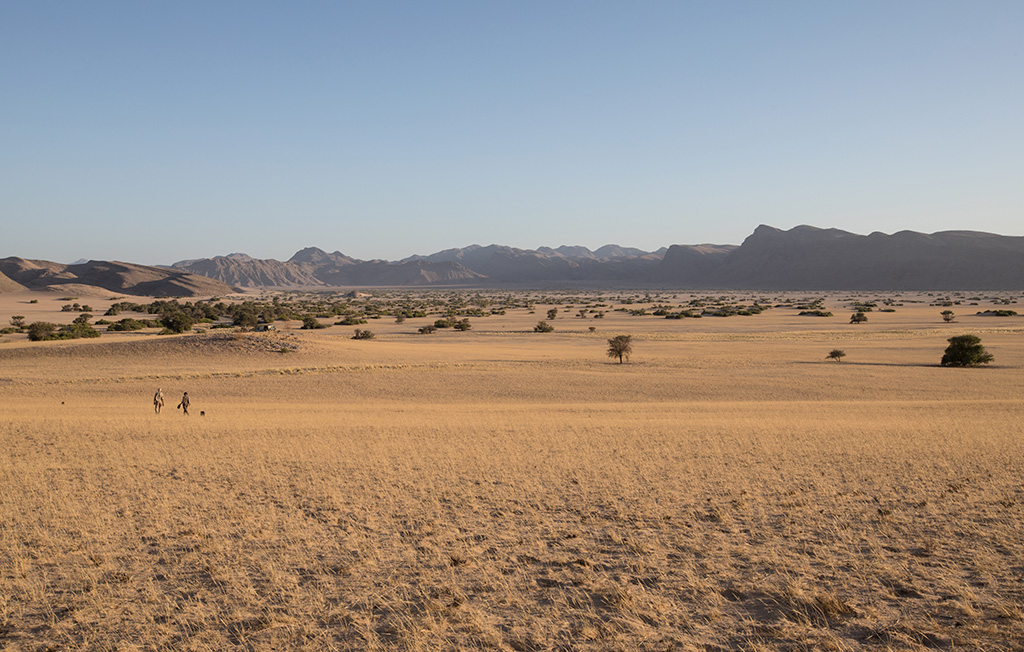
Despite the arid environment, after good rains, grasslands like this, north of the Hoanib Valley, are teeming with wildlife.
That river led us by a confluence to the Hoanib, home to a few luxury lodges that prize the valley for its beauty and wildlife. Garth had helped with the location of these lodges – the principle being to minimise their environmental impact – but our domain, as always, was our small tents in the rustic outdoors. That night we camped in a favourite spot of Garth and Margie’s looking over an immense swath of dry grassland encircled by distant mountains. We hiked up the hill behind the camp to look down on a miniature savannah speckled with ‘fairy’ circles on the other side. Perched at the top, with their staffies sitting faithfully alongside, we gazed down at the majesty of it in silence and I realised I was looking at these two remarkable people more than I was looking at the view, wondering at their thoughts. Turning around and descending, I watched them walk down in silence, hand in hand, and understood that I was climbing down into a world that was paramount to them; sacred and scarce.
That evening we watched giraffes browse on distant shrubs on the plain and a jackal on the prowl. We saw no other wildlife but after good rains this would become waist-high grass and great herds of springbok, elephant and cattle would tame its growth. As with all conservancy land, this was also pasture for livestock, and the reason, Garth explained, that no lodge was interested in this spot was because guests might be put off by the sight of livestock. Gazing over the incredible vista, I think he was glad for it.
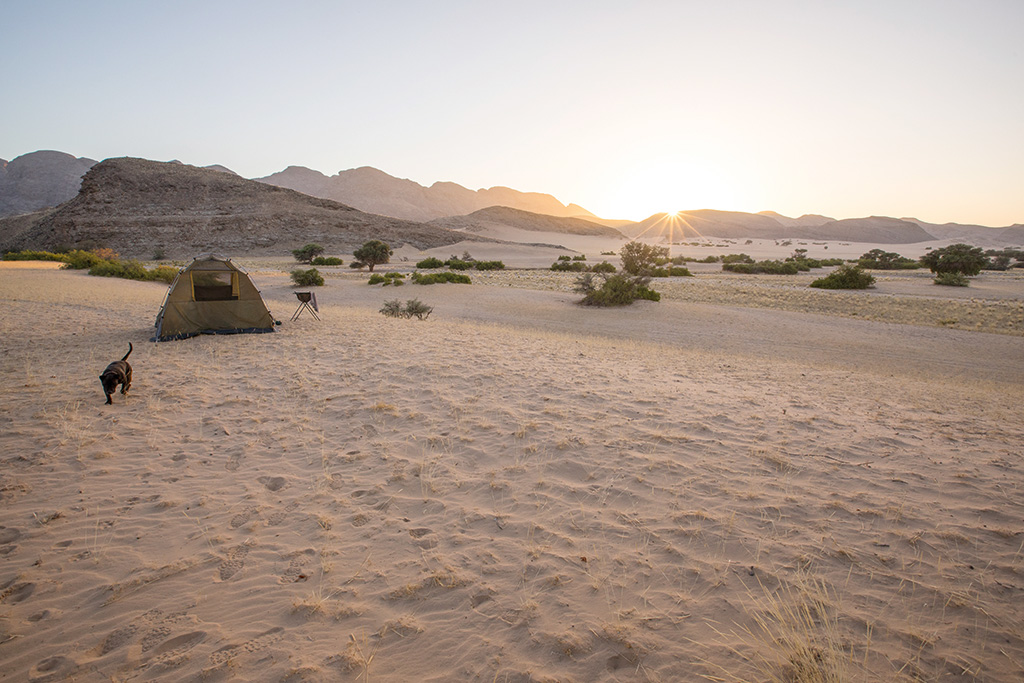
The author’s humble abode. A night far from any water source meant a peaceful sleep without the niggling soundtrack of lions.
For once, there was no sound of lions as we were far from the river. The preceding nights had been different. Camped along another sandy highway, the Uniab River, I woke numerous times to a lion calling nearby. The next morning we picked up the trail of a large male passing a few metres from our camp. Following the spoor in the Land Rover, elephant tracks obliterated the lion’s, and before long an old bull appeared, stretching his trunk to reach the seed pods at the top of a tree. The lion prints reappeared, leading us to a small spring where they mingled with those of juveniles and lionesses, a pride that had drunk there a short while before.
Later, on the northern edge of Torra Conservancy, we camped at the foot of hills cut by a rocky riverbed. As we sat around a fire that evening, a lion began calling, a sawing, rasping sound that echoed off the rocks.
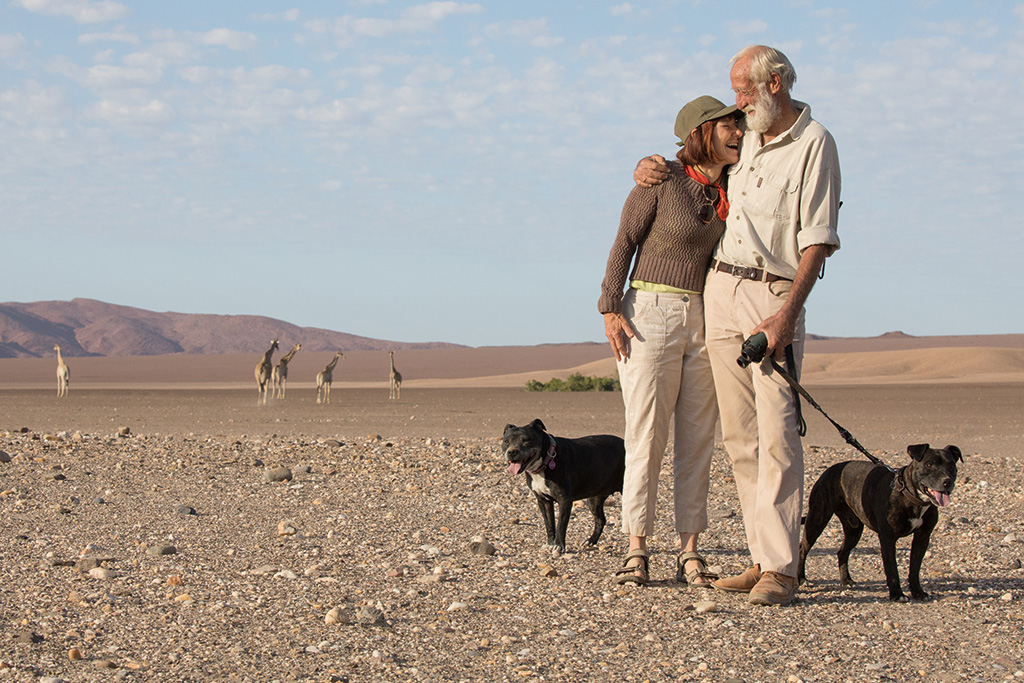
To really get to know them, read Garth’s book, An Arid Eden, and Margie’s Life Is Like A Kudu Horn: A Conservation Memoir.
‘It’s not the lions that you hear, it’s the lions you didn’t hear,’ Garth said, noticing my trepidation. Lying in my tent that night, it wasn’t the roaring that kept me awake, it was the silence in between. The following morning Boas Hambo, field co-ordinator of the local Rhino Ranger Project, drove into our camp. He’d planned to meet us the night before but just before reaching us he came across a pride of lions on the riverbank, no doubt the ones the male had been calling. He didn’t want to risk changing a flat tyre with them nearby, so he retreated to the safety of his patrol base.
For rangers like Boas and his team, wildlife encounters are common. In Torra Conservancy, much of the terrain we drove through was unforgiving. Billions of basalt rocks cover the earth, a rust-covered Mars-scape broken up by shrubs. I marvelled at the determination of these rangers who patrol this harsh land to protect the rhino and other wildlife with the threat of lions ever-present. Local pastoralists and villagers are under the same threat.
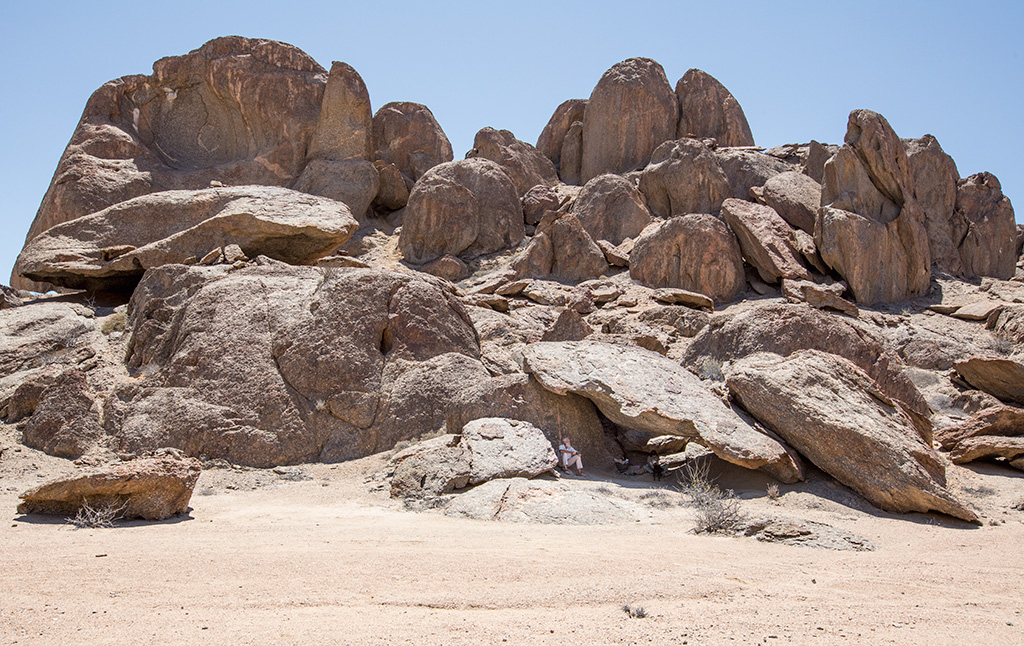
Dramatic rock formations as old as 1 500-million years dominate the north-west of Kaokoland and stretch on into Angola. They also provide welcome shade.
Visiting the chairperson of Torra Conservancy, Tommy Adams, he pointed out a small village saying that a woman there had suffered an enormous loss recently when a pride of lions got into her poorly-made kraal. ‘More than 100 goats were killed right there. That woman was crying on the ground,’ said Adams. ‘She said to me: “Tommy they’ve killed all my goats. Do you know how long it’s taken me to build that herd? Take them! Eat them. Now I have nothing”.’
This is not uncommon during drought. During the last major drought in the early 1980s, a record 98 sheep and 17 goats were killed by predators in one attack. By the time I visited in November 2017, that record had been broken twice that year, and then again in January 2018 when 172 sheep were killed by lions near the Huab River.
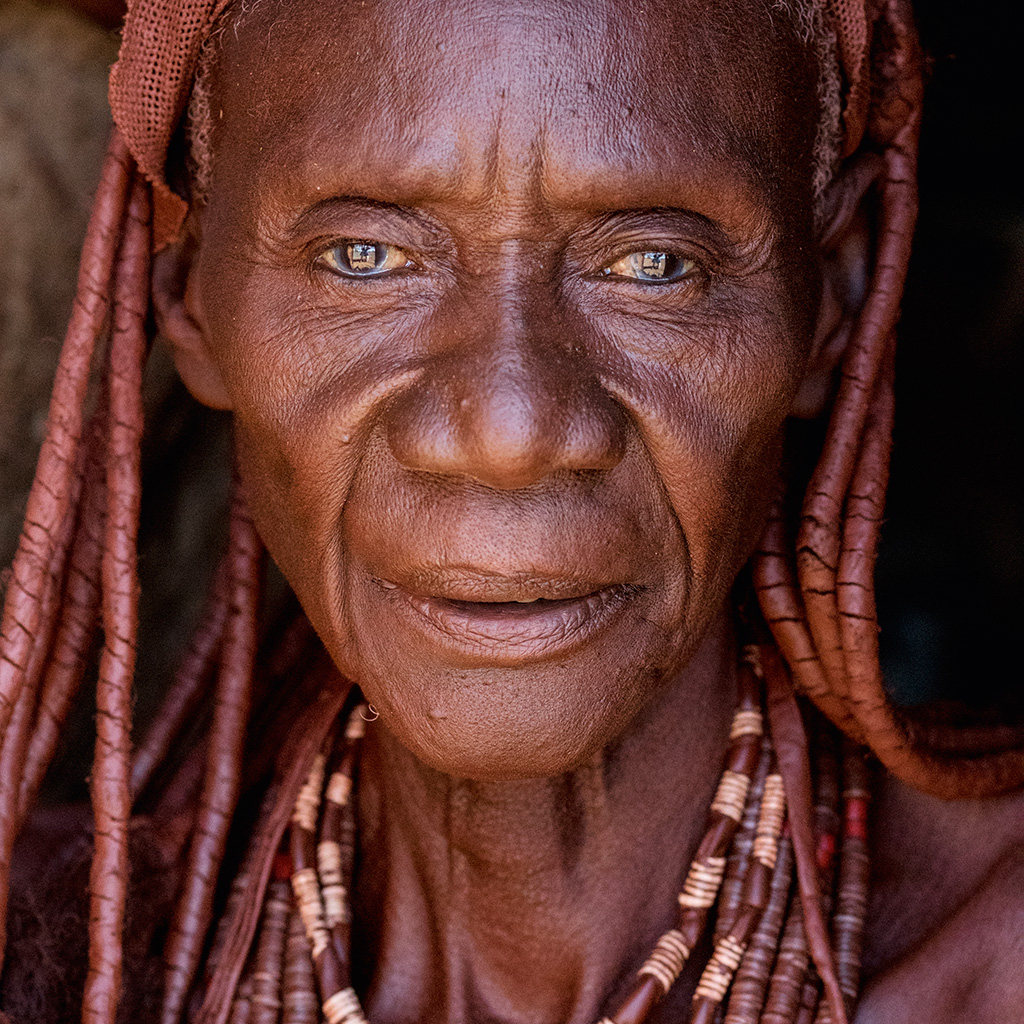
Himba women rub a mixture of butter fat and ochre into their skin and hair, protecting them against the harsh climate.
It must be difficult for communities to see the benefits of living with wildlife when the threat of predators weighs so heavily on them; pressure is on the government and NGOs to help contain it. Part of the solution is the capture and relocation of problem animals, but out of frustration, some locals shoot them. Preventative measures such as reinforcing kraals and early warning systems are being introduced but bureaucracy and lack of funds slows things down.
But there is progress, and the broader picture reveals a more promising situation that Garth and Margie have been instrumental in establishing. Through 83 registered conservancies in Namibia, wildlife conservation is increasingly linked to rural development. Profits from tour and hunting operators, concession and land leases go into community and conservation initiatives. Through this, communities are seeing the value in wildlife. Most wild species have increased in the north-west Kunene and Caprivi regions, and poaching is being brought under control with input from community-appointed game guards and locals who understand the importance of wildlife. Without their work, much of what sustenance one can find in this enormous arid wilderness would be over-utilised by farmers and there would be little wildlife to speak of.

Masters at sniffing out water deep beneath the surface of the Hoanib riverbed.
I learnt of this couple’s achievements from Tony Weaver and through my own research. Garth was a quiet, humble man –no point in wasting energy on pride in this desert heat, rather he put his energy into a hands-on experience, and despite his age and battles with cancer, he was remarkably active. We arrived at Puros Community Campsite in the dry Hoarusib Riverbed one afternoon, the mercury reading 38°C. A thicket of trees cast welcome shadow. It was the logical place to pitch my tent. I was soon asleep inside. Garth, on the other hand, went walkabout. He woke me not long before sunset. ‘Elephants. Come with me.’ Trying to keep up with his long strides, we passed the tent he and Margie had pitched in baking sunlight. Namibians are hardcore, I thought.
We followed the elephant spoor along the riverbed, and there, tugging at a canopy of ana trees, was a small herd. With careful analysis of the breeze and constant scanning for any elephants that were separate from the herd, we moved closer until we could hear their deep satisfied rumbles. A change in the air, a gruff snort from a trunk and Garth took the cue to back away. ‘Be careful,’ Garth said as we walked back to our tents. ‘A camper went for a jog recently. Ran into a herd and was killed right here.’
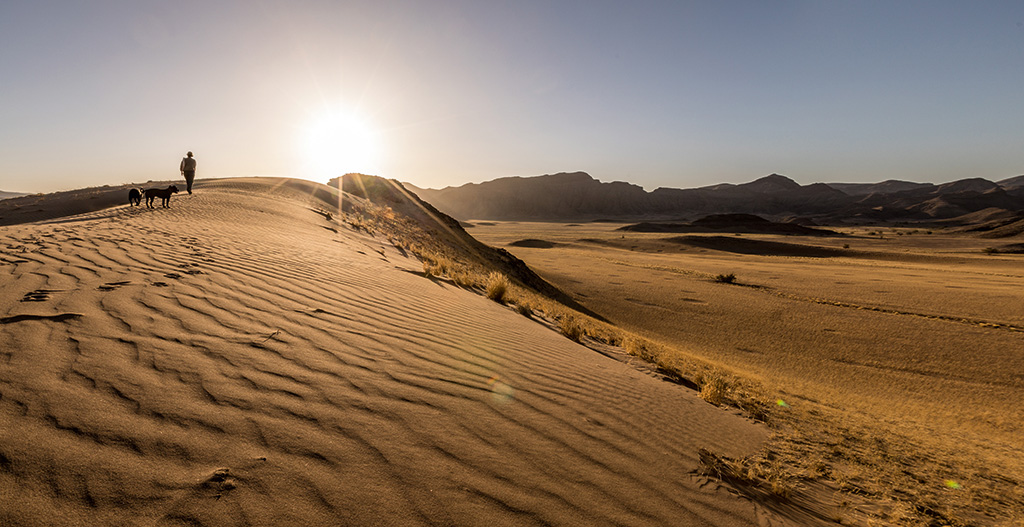
Once the sun goes down, summer temperatures drop to about 20°C compared to about 35°C in the day.
Then it was dinner around the fire and the night’s curtain was drawn. Off to our tents we went, to sleep, perchance to dream. My dream was full of great rolling rumbles peeling through the fabric of my tent. Then a tap, tap, tappety-tap as twigs and leaves tricked down from the trees. I woke with a whimper as another rumble rolled through my core, and by the faint moonlight, through the tent gauze, I studied the wrinkles of a great grey beast looming above me, and the swishing trunk of another then a flash of ivory as it stretched up to reach the canopy. And so it continued for an age, the sweet rumble of elephants feeding on the ana trees above me, and it lulled me to sleep.
I imagine Garth sleeps just as peacefully.
Planning a trip to northern Namibia?
Without experience and a well-tested sense of self-reliance, travelling the remote byways of Kaokoland on your own can be a challenge.
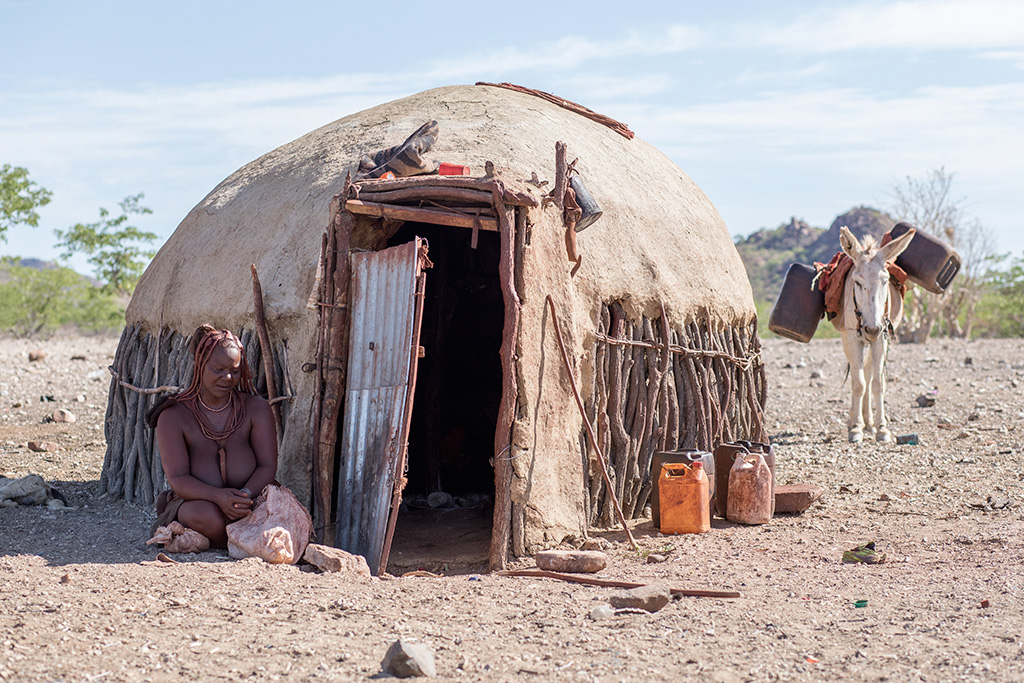
A humble Himba hut, a fundamental way of life – which is one Margie understands better than most having lived and worked with Namibia’s nomads for years.
Tips
Conduct extensive research and ask advice from people who have had experience self-driving Kaokoland on popular overland forums such as 4x4community.co.za
4×4 vehicles are essential and ideally you should travel with at least two cars.
If you travel alone, take a satellite phone.
Your vehicle needs to be equipped with recovery gear, at least two spare tyres, a tyre-repair kit and compressor. Travel is on a variety of surfaces from sharp rock to deep sand, each of which needs its own pressure setting.
You need to be self-sufficient with regards to food, water and petrol. The going is slow on many routes – in some cases, such as Van Zyl’s Pass, you can expect to travel just 50km in an entire day.
Stock up on fuel, water and food wherever you find the opportunity.
Vehicle Hire
A variety of reputable 4×4 hire companies have outlets in Windhoek and Swakopmund supplying fully kitted rigs for such journeys. Some also offer back-up support and the latest, most reliable vehicles. Good research will reveal the best for you; at the top of our list is Bushlore Africa 011 312 8084 bushlore.com and Britz 011 230 5200 britz.co.za

A humble Himba hut, a fundamental way of life – which is one Margie understands better than most having lived and worked with Namibia’s nomads for years.
Guided Trip
Live the Journey offers a variety of guided self-drive tours in Namibia. Take your own 4×4 on their 10-day Seven Rivers tour of northern Namibia, 20–30 September 2021. R15 300 per adult based on a group of 20 adults. Children from R3 900. 021 863 6400 livethejourney.co.za
Conservancy Safaris Namibia (CSN) is community owned with more than 3 000 Himba and Herero shareholders. Originally guided by Garth Owen-Smith, CSN expeditions give unique access to parts of the region few other visitors have been. The team knows the wildlife and culture of the region better than anyone, and the itineraries are kept flexible to adjust to the seasonal wildlife and nomadic Himba movements, as well as the special interests of guests. Daily rates are from R7 600 pp. +264 6440 61 36/35 kcs-namibia.com

